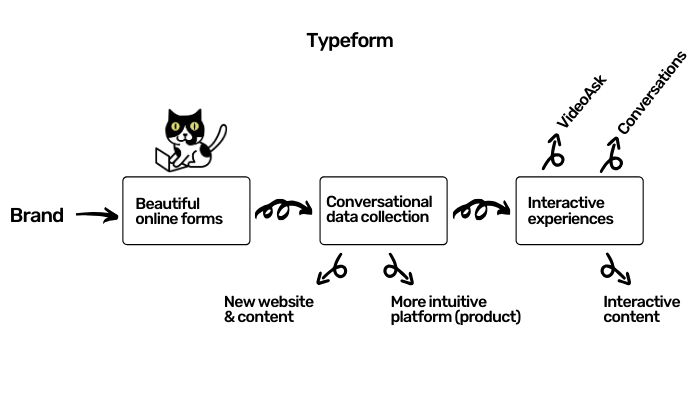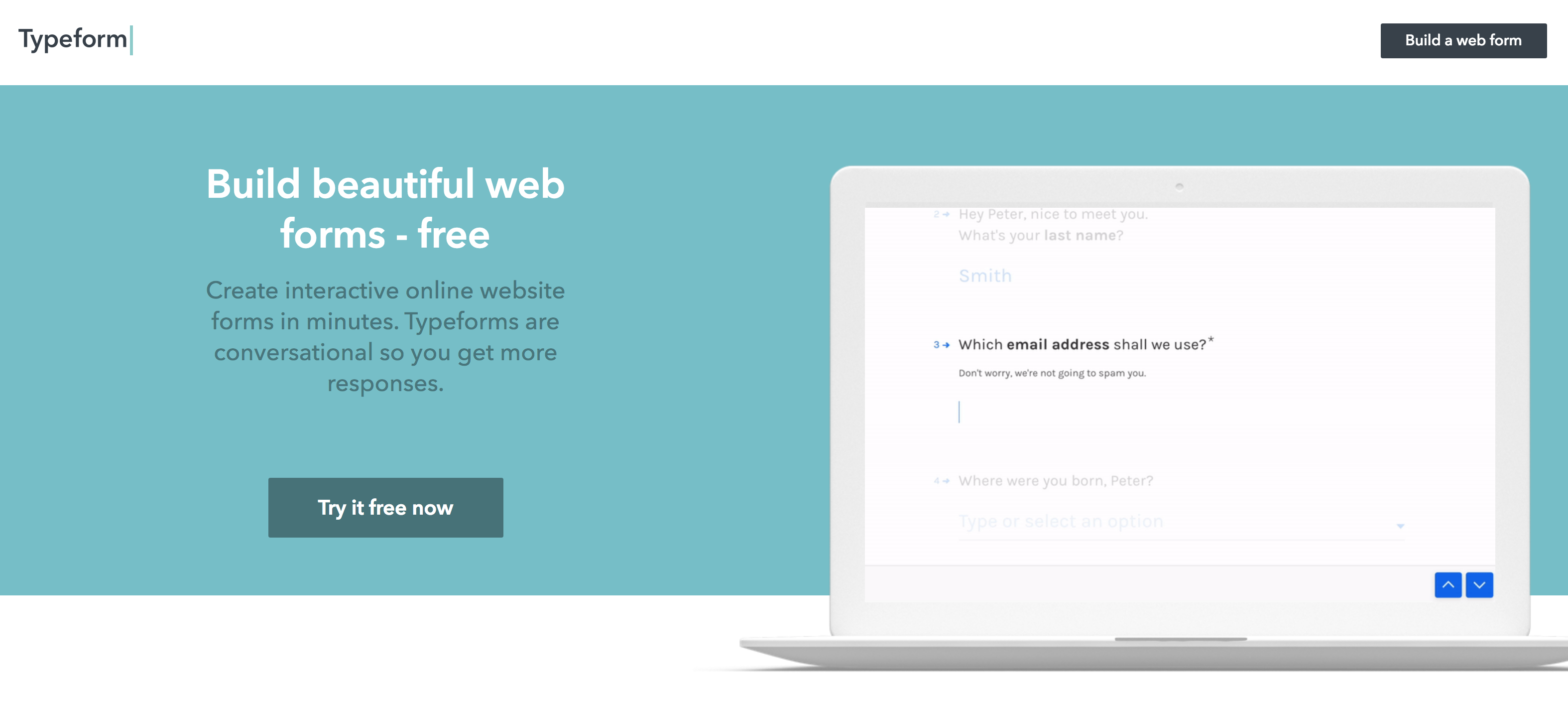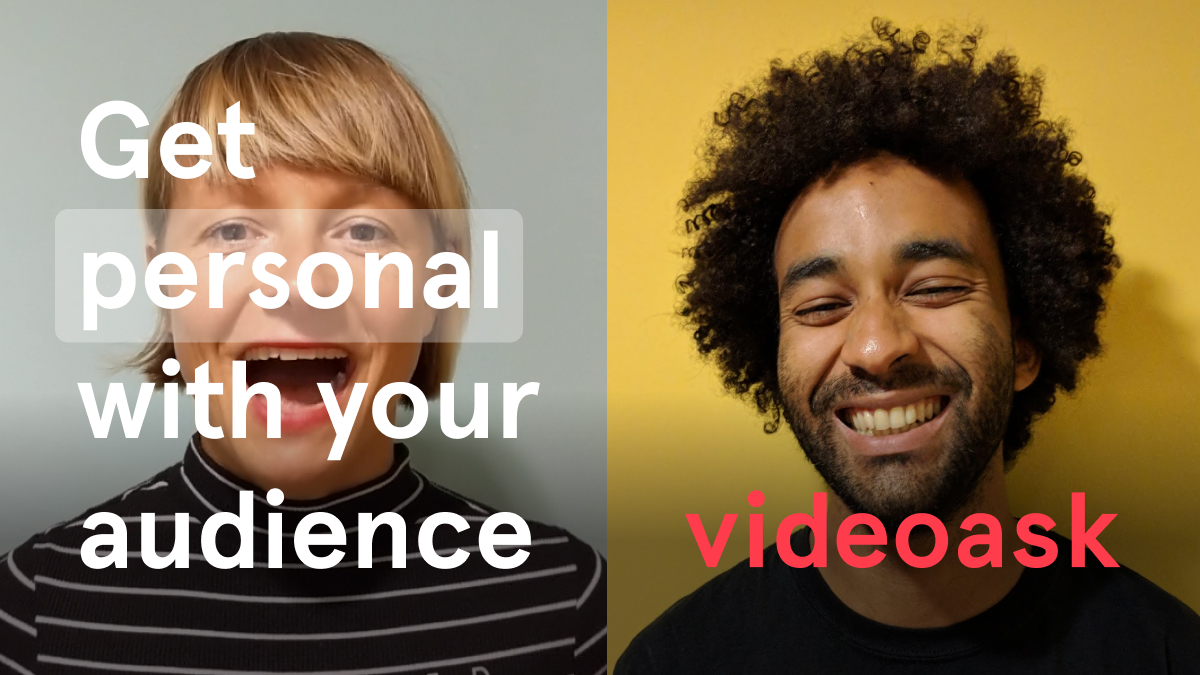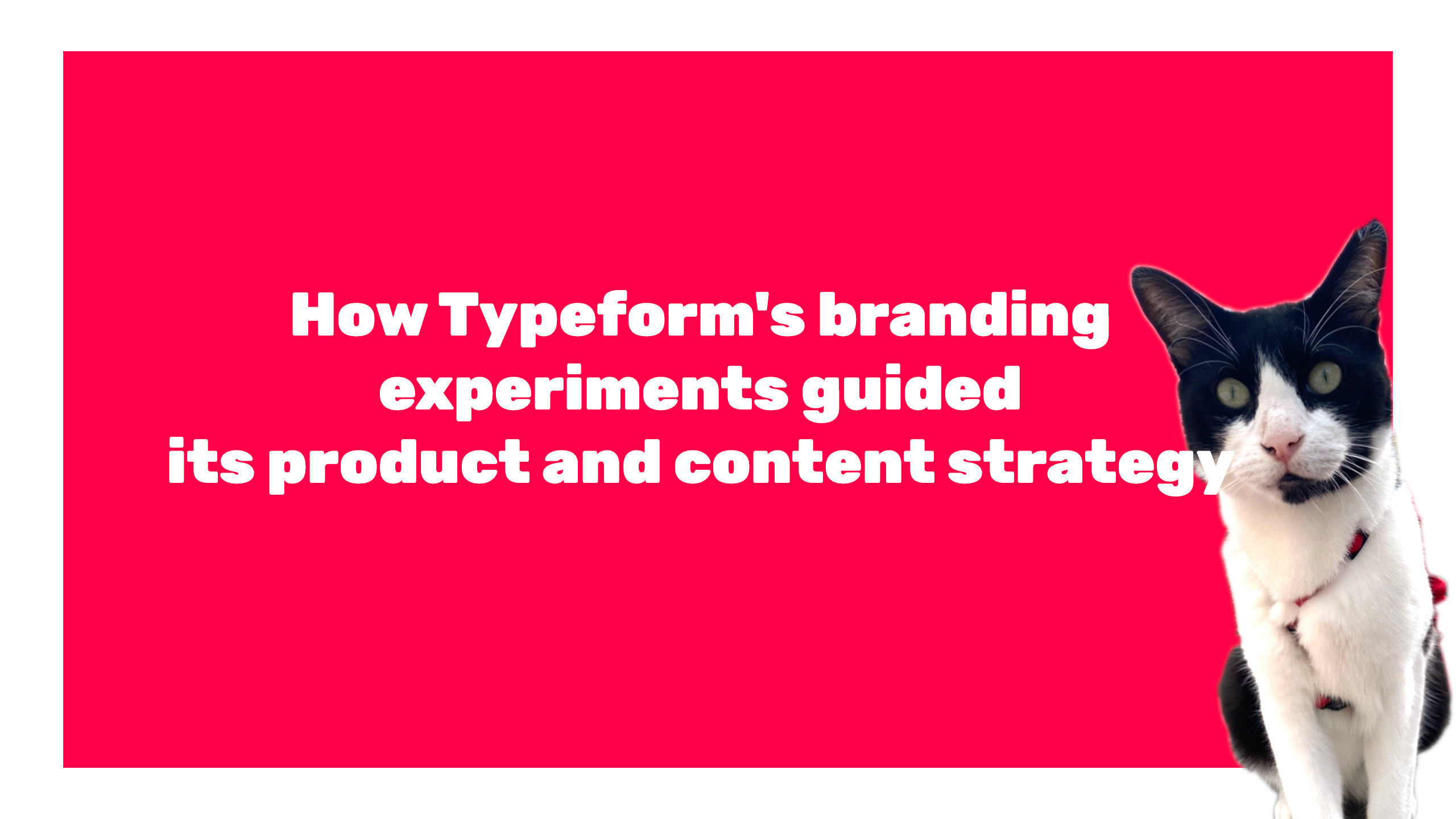Branding. Storytelling. Conversations. Content.
Each has its own role, but they all have the same goal: to build trust.
We all know Typeform as a way to create beautiful online forms to make your website stand out.
They also create experiences for brands to interact with their audiences. The focus is interaction, so their brand journey taught them that their content should be interactive, too.
They let their brand proposition and their user’s requests guide their product and content.
VideoAsk, one of their new products, is a feature that lets you have video-recorded conversations with your users. It’s less centered on design. Because it’s not so much meant to give brands beautiful design, more than it gives brands a way to get to know their users.
It’s user-focused, and used to tell stories. So their content marketing is made of users’ stories.
Alex Antolino, Creative Director of Typeform, told me about the story of how Typeform evolved, and how new products emerged as a result of being guided by their brand.
[tcb-script src=”https://www.buzzsprout.com/1399351/5785132-1-how-typeform-s-branding-experiments-guided-its-content-and-product-strategy.js?container_id=buzzsprout-player-5785132&player=small” type=”text/javascript” charset=”utf-8″][/tcb-script]
Brands are like people. They’re characters, and characters evolve.
Alex began working in film. He joined this small startup to make tutorials, and through a series of fortuitous events, became the creative director.
Just like people, brands evolve, change and learn who they are based on experimenting and having conversations.
Branding is more than design
Branding isn’t just a visual identity.
Creating a PDF of your logo, fonts and colors doesn’t mean you’ve created a brand.
Not even writing a mission statement or a list of your values is enough.
Those are all components of it, but they aren’t what make a brand.
Neumeier said it best in The Brand Gap: “A brand is a person’s gut feeling about a product, service or company.”
Design is a huge influence. Without a clean, attractive design – something that’s easy to consume – people won’t feel that you’re a brand worth taking seriously.
The same can be said about a brand’s content.
Brands that have no content can never be seen as thought leaders – how could they? What demonstrates that they know anything, if they have no content to show it?
And in a world where there are 100s, if not thousands of other companies offering the same product as yours – the only thing that makes your brand stand out from the rest is people’s gut feeling about you. It’s whether they know, like and trust your brand.
Trust makes competition irrelevant.
How branding builds trust
“Brands are like people. Brands are like characters.
A brand’s purpose is to build trust. That’s it.
It’s not to make money and not even scale the business. The sole purpose of a brand is to build trust with the audience that that brand is communicating to” Alex told me.
Trust is a few things:
- Coherence
- Consistency
- People know what to expect
But, and perhaps most importantly, trust means that your audience knows you care about them.
“I can only trust someone that I know cares to a certain degree about me.
If I don’t think you really care about me, I’m not going to trust you. You could be the best professional in the world, the best agency.
If you don’t give a shit, I’m not gonna buy your service” Alex continued.
Typeform did that by listening to their audience and letting that guide their brand and content.
Typeform’s brand adventure
Branding is a visual experience, and Typeform’s MO from the beginning was to make beautiful forms.
It was to help other companies gain credibility with beautiful design.
This is what most people understand about branding: your company’s credibility is judged by its attractiveness, and that’s what branding is for.
Branding isn’t about making things only esthetically attractive – but attractive as a whole.
Both founders came from a design background. Good design builds authority. Making sure every point of interaction with your customer – down to the form they fill out on the website – is designed well, helps brands build trust through authority.
Jeremy Miller, author of Sticky Branding, explains this:
“Your brand will be judged at every visual touch point, and your customers will decide if your firm is a fit for them based on what they see. Is your company credible or not? Yes or no? Their eyes will make the decision.”
The design merges with the message and tells your viewers whether you take your brand seriously or not and, ergo, whether they should take your brand seriously or not.
So Typeform started as a way for companies to easily build this authority.

Beautiful online forms
When Typeform began, its unique proposition was creating online forms that didn’t feel like forms. The first form with good UI ever created.
Years passed before they started asking themselves:
“What is this thing that we’re doing? Is it forms or is it something else? The function is the same and the utility is the same. But at the end of the day, it’s just so different on the outside. What makes it different was the experience. So what are we dealing with?” Alex said.
What really makes a product stand out isn’t the product itself. It’s the brand.
After some years of considering what they were really about, Typeform underwent its first rebranding.

Typeform’s first brand positioning was Beautiful Online Forms
Conversational data collection
Typeform knew it was more than just attractive online forms.
It was about starting conversations and having a human experience.
Their original tagline was “make things a little more human”
But what did that mean?
Their proposition made sense and resonated with their team, but failed to guide them in their major decisions. How could they gauge whether things were more human or not?
After a year of working with a branding company, Typeform came up with a new vision:
“In business, we thrive when we care about each other. It all starts by really getting to know someone.”
And “really know people” became their new brand proposition.

Their next positiong was Conversational Data Collection
This brand proposition helped guide them – developers and design teams knew that everything they experimented with should have this goal in mind.
That’s when they experimented with a more conversational way to get to know their customers better on their own blog.
Typeform’s advertising failure in their first rebrand
When Typeform decided to go for conversational data collection, they had an idea to release a TV ad in the US West Coast.
“We decided to create a commercial like very classic, 30-second advertisement form. And we decided to put it out, say, ‘hey, we do conversational data collection.’
Yeah, it was so naive and we spent a gross amount of money on that. We put it out. It didn’t work. It was awful. It was terrible. And we had to pull it. The whole thing went so poorly. I mean, it was crazy.”
But it was a good learning experience, as are all failures.
A brand-driven content piece became a product feature
Trying to salvage the performance of the ad, Typeform was trying to find out how to communicate their new offer to the world.
They knew they had to go beyond just another blog post – Alex and his team decided to make it a little more interactive and conversational, in line with their new brand.
They were inspired by those DVD packs that included the director’s cut.
“So we were like, what would it look like if we did the same thing for a blog article? We applied Typeform technology to have a pre-scripted conversation with the author of the blog, like if he were sitting next to you.”
Its success was astronomical.
So much so, that people wanted their feature on their own blog. This wasn’t Typeform’s plan – their plan was to have more conversations with their customers, to “really get to know them.”
The branding decision to be more human, move to conversational data collection, led their content strategy, which resulted in a new product feature.
Interactive experiences
Typeform’s most recent positioning is interactive experiences.
With the adding of so many features, it’s become so much more than just beautiful online forms or conversational data collection. It’s now a go-to provider of online interactive experiences.
This came, as well, from an accident.
Alex and his team did a hackathon, creating an interactive story for which the user can create the fate of the character.
They recorded the whole thing in his apartment over 48 hours.
The sleepless 2-day streak provided no fruit at first. They didn’t win the hackathon.
They archived the interactive video experience. It sat untouched for over a year.
Until Halloween, Alex remembered it – which coincidentally, had a Halloween-esque theme.
“We put it out and people went nuts. Like over a weekend we got more than like 4000 feature requests, which for us is huge.”
They realized that every time they launched something interactive, they were successful.
Now Typeform offers more than online forms: its new features include VideoAsk, an experimental video app where people can talk with your brand through videos, and a brand new feature called Brand Compass, where people can explore and learn about their own brand.
Now, every decision is guided by being an interactive experience.
And the content they put out is, naturally, interactive too.
Your brand proposition should drive content
If you don’t know who your brand is, it’s hard to guide your content decisions.
You can’t deliver value without a strong brand proposition – if you don’t know what you stand for, how can you amplify it?
Content should be created intentionally, with a story to tell that’s in line with your brand. That’s how you build relationships with your audience – people relate to stories and relationships.
But a story that doesn’t engage your audience doesn’t mean much. It doesn’t build trust, so it doesn’t do the brand’s job.
Typeform’s failed advertising experiment was to announce their new product. But it wasn’t in line with their brand proposition, so it didn’t work. They didn’t talk to their audience before investing in it.
Typeform’s selling proposition is to help your brand build authority with beautiful design. So their design has to be beautiful, and it has to portray authority.
Their new feature, VideoAsk, is about starting conversations with users and creating a connection. So design is less important – the focus is on the users themselves. All the content created for VideoAsk is user-generated. The logo matters less, but the brand matters all the same.

Typeform’s new product, VideoAsk lets you have video conversations with your users
“Typeform is a movie based on real facts and VideoAsk is like a documentary” Alex told me.
That’s their product, and it’s reflected in their content:
- Typeform creates fun, interactive experiences (like a movie)
- VideoAsk tells the stories of their audience
When you have a defined brand proposition, your content should be aligned with it. Otherwise, it means little.
Typeform’s content driving product
Typeform’s brand-driven content helped them discover features their audience was looking for.
It helped them find features that differentiated them more from just another form-builder.
The reason is that they experimented, they focused on their users and they listened to them.
As they grow, they keep using their brand proposition to guide them in product and content, and they embrace what their users say. We saw what happened when they worked on an off-brand marketer’s hunch – the TV advertisement failed miserably. They don’t work in a vacuum – they’re constantly listening and adapting based on what their users expect and need.
The purpose of content: to build trust
The purpose of brand and content are one and the same.
To build trust and authority.
Those are the two things that differentiate your product from the deluge of other products that are exactly the same as yours.
If your audience trusts you on every level, it won’t matter that other products are the same, and it won’t matter that they’re cheaper.
Relationships take work and are never one-sided
Typeform found their new brand identity by starting conversations.
It learned from its users, employees, and all the people who interact with its brand.
“When enough individuals arrive at the same gut feeling a company can be said to have a brand”, says Neumeier in The Brand Gap.
You can embrace and influence that gut feeling by having conversations with the people who have it.
Everyone has the opportunity to build relationships, create content and create a brand.
But nobody likes someone who only talks about themselves. People have conversations every day. Why shouldn’t your brand have conversations with your audience, too? Why shouldn’t this be what drives your decisions?
Typeform’s interactive content worked because their audience expects interactive experience from them. That’s why their interactive product features have explosive success.
Brand- and user-driven content is organic, human, authentic and build relationships. Ultimately, it breaks companies free of indifference.
Connect with Alex Antolino on LinkedIn, Instagram, Twitter and YouTube.
Want to receive these expert interviews, how-tos guides and tips straight to your inbox? Sign up to the Flying Cat Marketing email list. Only value, no spam.
